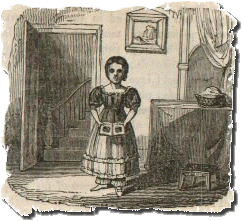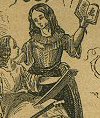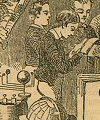NINETEENTH-CENTURY AMERICAN CHILDREN & WHAT THEY READ:
Some of Their Magazines
About 430 periodicals for children were founded in the U. S. before 1873. Learn more about them at “American Children’s Periodicals, 1789-1872,” an ever-growing descriptive bibliography.
Works on pre-1873 American children’s periodicals are listed or transcribed in a separate bibliography.
Puzzles appeared in most nineteenth-century American magazines for children. The Puzzle Drawer is a selection of puzzles printed in Woodworth’s Youth’s Cabinet and Robert Merry’s Museum. They range from the easy to one designed to be impossible. Try your wits! (And your patience!)
Devoted to “the physical, moral, and intellectual improvement of youth,” The Student focused on current events and on subjects covered in 19th-century American schools. In 1854 it was, in fact, subtitled “A Family Miscellany and Monthly School-Reader.” The editor, N. A. Calkins, offered something for everyone: “children” got a few pages of brief stories printed in a font slightly larger than that in the rest of the magazine, with a fair bit of white space; “youths” got stories in a slightly smaller font. The other pages in each issue were in an even smaller font. There was a column of trivia and a column of current events; a section of advice for parents and teachers; some music; a few puzzles; an editorial; and reviews of new books. In 1855, the magazine merged with The Schoolmate to form The Student and Schoolmate.
Four types of readers were accommodated by four layouts and type sizes, since the magazine was intended to appeal to everyone from inexperienced readers to parents and teachers.
“Letters About Geology,” by “Professor Pickaxe” (1853) gives readers an introduction to the geologic record and to some of the prehistoric creatures that had been discovered.
“Henry Sanford’s Teacher,” by Eliza A. Chase (May 1853) shows that students have always tried to circumvent the process of education.
This brief review of Fern Leaves from Fanny’s Portfolio (September 1853) probably concerns the first series.
“Placing a Daughter at School” (November 1853), by Motte Hall, is a humorous look at the expectations of parents, reprinted from Godey’s Lady’s Book.
Two pieces about books (February 1854) appeared in “Our Museum,” a regular column of trivia pieces: the sizes of paper used in printing, the sizes of books, and how to figure the quantity of paper needed to print a thousand copies.
Intended to supplement a child’s education, The Schoolmate printed poems and music, puzzles and stories. But it is best known for its emphasis on instruction in reading aloud and speaking; each issue included dialogs and excerpts from contemporary speeches, along with charts demonstrating “proper” reading style and appropriate gestures for speech-making. Whether young speakers actually understood the polysyllabic phrases is another matter!
“Wonders of Geology” (March 1852) recreates the prehistoric past in words and in illustrations of creatures like the megatherium, the plesiosaur, and the dinotherium; it was one of the early works on fossils in early American works for children.
“Daguerreotypes of the Moon” (January 1854) describes John A. Whipple’s procedure for photographing the moon and notes that photographs may be useful to astronomers in the future.
Formed of a merger of The Student with The Schoolmate, Student and Schoolmate retained the latter’s emphasis on education—and its dialogs and speeches. An excerpt from a speech appeared in each issue, with an abbreviated chart of appropriate gestures. After William T. Adams (“Oliver Optic”) became editor in 1858, the magazine printed works by him and by Horatio Alger (Ragged Dick was serialized here.)
“The Atlantic Telegraph” (October 1858) is an excerpt from a lyceum speech extolling not only the telegraph, but the way that “the blind capital of commerce follows on the glowing trail of ideas springing from the heads of our industrial sovereigns.”
“The Union” (January 1861) editorializes about the principles involved, as the American states went to war with each other.
“The Stars and Stripes” (July 1861), by John A. Andrew, glorifies the idea of Union, during the American Civil War, in a speech to be recited with gestures.
“Hail, Columbia!” (August 1861) reminded readers of some basic truths in the first months of the Civil War.
“Our Heroic Dead” (February 1863) is an excerpt from a speech by Governer Andrew honoring those from Massachusetts who died in battle.
Editorial from the “Teacher’s Desk” (February 1863) offers cheering words to war-weary readers who were, the magazine reminded them, living through an important event.
“Clara’s Medal” (September 1864), by Christie Pearl, shows that cheaters may only seem to prosper.
“The Best Girl in School,” (October 1864), by Phoebe H. Phelps, gives girls an ideal of humility and modesty to follow in school.
“Industry and Idleness” (November 1864), by William L. Williams, details the consequences of goofing off in school—and includes an early slap at dime novels.
“Katie’s Sacrifice” (November 1864), by E. N. H., shows that even young children can sacrifice for the Union cause—and that a good story can always be recycled.
“The American Flag” (April 1865), by Mrs. P. A. Hanaford, is a cheery little piece asserting that “This is the flag for me!”
“July 4, 1865, by “Lulie,” is a cheery celebration for a memorable Independence Day, at the end of the American Civil War.
An editorial from the “Teacher’s Desk” (July 1865) reminds readers that, though the Civil War was over, there still was much to be done for the country.
To “Nineteenth-Century American Children & What They Read”
Some of the children | Some of their books | Some of their magazines
Some works for adults, 1800-1872



